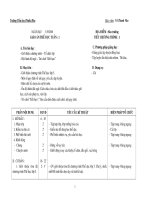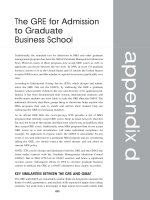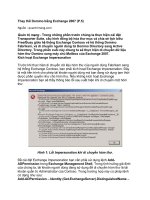Tài liệu Conserving the Future Force Fighting Strength - Findings from the Army Medical Department Transformation Workshop 2002 pptx
Bạn đang xem bản rút gọn của tài liệu. Xem và tải ngay bản đầy đủ của tài liệu tại đây (1.54 MB, 125 trang )
Findings from the Army Medical
Department Transformation
Workshops, 2002
Conserving the
Future Force
Fighting Strength
David E. Johnson
Gary Cecchine
Prepared for the United States Army
Approved for public release, distribution unlimited
The RAND Corporation is a nonprofit research organization providing
objective analysis and effective solutions that address the challenges
facing the public and private sectors around the world. RAND’s
publications do not necessarily reflect the opinions of its research clients
and sponsors.
R
®
is a registered trademark.
© Copyright 2004 RAND Corporation
All rights reserved. No part of this book may be reproduced in any form
by any electronic or mechanical means (including photocopying,
recording, or information storage and retrieval) without permission in
writing from RAND.
Published 2004 by the RAND Corporation
1700 Main Street, P.O. Box 2138, Santa Monica, CA 90407-2138
1200 South Hayes Street, Arlington, VA 22202-5050
201 North Craig Street, Suite 202, Pittsburgh, PA 15213-1516
RAND URL: />To order RAND documents or to obtain additional information, contact
Distribution Services: Telephone: (310) 451-7002;
Fax: (310) 451-6915; Email:
Library of Congress Cataloging-in-Publication Data
Johnson, David E., 1950 Oct. 16-
Conserving the future force fighting strength : findings from the Army Medical
Department Transformation Workshops, 2002 / David E. Johnson, Gary Cecchine.
p. cm.
“MG-103.”
ISBN 0-8330-3541-X (pbk.)
1. United States. Army—Medical care—Evaluation. I. Cecchine, Gary. II. United
States. Army Medical Dept. III.Title.
UH223.J64 2004
355.3'45'0973—dc22
2003027173
The research described in this report was sponsored by the United States
Army under Contract No. DASW01-01-C-0003.
iii
Preface
This report is one in a series that documents the Army Medical De-
partment’s process of identifying medical issues in the Army’s Trans-
formation. It contains an assessment of the three AMEDD Trans-
formation Workshops (ATW I–III) conducted at the RAND
Washington Office on 16–18 April, 27–29 August, and 5–6 Novem-
ber 2002. The report describes the development of issues that pro-
vided a basis for the workshops, workshop organization, the composi-
tion of the various teams and cells, objectives and issues, the scenario
used, and the analysis methodology employed. Finally, the report
provides results and observations.
The Commanding General, U.S. Army Medical Department
Center and School sponsored this work, which was conducted jointly
by RAND Arroyo Center’s Manpower and Training Program and
RAND Health’s Center for Military Health Policy Research. RAND
Arroyo Center, part of the RAND Corporation, is a federally funded
research and development center sponsored by the United States
Army. Comments and inquiries should be addressed to the authors.
iv Conserving the Future Force Fighting Strength
For more information on RAND Arroyo Center, contact the
Director of Operations (telephone 310-393-0411, extension 6419;
FAX 310-451-6952; e-mail ), or visit
Arroyo’s web site at />v
The RAND Corporation Quality Assurance Process
Peer review is an integral part of all RAND research projects. Prior to
publication, this document, as with all documents in the RAND
monograph series, was subject to a quality assurance process to ensure
that the research meets several standards, including the following:
The problem is well formulated; the research approach is well de-
signed and well executed; the data and assumptions are sound; the
findings are useful and advance knowledge; the implications and rec-
ommendations follow logically from the findings and are explained
thoroughly; the documentation is accurate, understandable, cogent,
and temperate in tone; the research demonstrates understanding of
related previous studies; and the research is relevant, objective, inde-
pendent, and balanced. Peer review is conducted by research profes-
sionals who were not members of the project team.
RAND routinely reviews and refines its quality assurance pro-
cess and also conducts periodic external and internal reviews of the
quality of its body of work. For additional details regarding the
RAND quality assurance process, visit />standards/.
vii
Contents
Preface iii
Figures
ix
Tables
xi
Summary
xiii
Acknowledgments
xxi
Glossary
xxiii
CHAPTER ONE
Introduction and Background 1
Background of AMEDD Transformation Efforts
1
Toward a New AMEDD Analytical Process
2
Redefining AMEDD Transformation Issues
3
Medical Risk as an Analytical Foundation
3
RAND Process to Redefine Issues
4
Designing a New AMEDD Analytical Process
5
CHAPTER TWO
AMEDD Transformation Workshop Design 9
Organization
10
Workshop Teams
10
Control/Administrative Support Cell
10
Workshop Objectives and Issues
12
Objectives
12
Issues
13
Scenario
13
viii Conserving the Future Force Fighting Strength
Sequence of Events 16
ATW I and II
16
ATW III
16
Methodology
16
ATW I
17
ATW II
18
CHAPTER THREE
Workshop Results 21
ATW I and II
21
Casualty Outcomes, Status of HSS Resources, and Advice to the
Commander
22
Issue Resolution
24
ATW III
27
CHAPTER FOUR
Observations and Conclusions 29
Specific Workshop Observations
30
Broader Workshop Implications
31
Workshop Implications for the HSS System
31
Workshop Implications for the Army
36
Conclusion
38
APPENDIX
A. Restated AMEDD Transformation Issues 39
B. Team Members, ATW I–III
49
C. Medical Technologies Employed in ATW I–III
53
D. Casualty Determination Process
79
E. Casualty Tracking Worksheet
81
F. Step Three Worksheet
89
G. Treatment Briefs
97
ix
Figures
1. AMEDD Transformation Workshop Structure 11
2. AMEDD Transformation Workshops Methodology
19
xi
Tables
S.1. Mean Casualty Outcomes at H+8 hours xvi
1. Mean Casualty Outcomes at H+8 hours
22
A.1. Issue Assessment Categories and Potential Scores
39
xiii
Summary
This report details the results of the Army Medical Department
Transformation Workshops (ATW) held in April, August, and
November 2002, and it includes a RAND Corporation assessment
and discussion of the workshop results. The purpose of these work-
shops was to initiate an assessment of the medical risks associated
with emerging Army operational concepts and the capacity of the
Army Medical Department (AMEDD) to mitigate these risks. Medi-
cal risk, discussed later in this report, is defined generally as the num-
ber, severity, and fate of casualties incurred.
Background
The Army’s transformation to a future force not only posits dramati-
cally different equipment, it also envisions radically new ways of
fighting. One future development of particular importance will be the
employment of widely dispersed units moving rapidly around the
battlefield. These operational concepts pose enormous challenges for
the units that support the combat elements. In 1998, the AMEDD
began an analytic effort to gain insight into the challenges for health
service support (HSS) posed by emerging Army concepts.
1
Over the
next few years, AMEDD conducted two games and several work-
_____________
1
AMEDD’s analytic effort has included broad aspects of HSS, to include homeland
security, recruiting, retention, etc., in addition to combat HSS, which is the focus of this
report.
xiv Conserving the Future Force Fighting Strength
shops to provide further insight into how it could best support the
Army as it transformed.
From these various events, AMEDD derived some 250 issues,
which they eventually winnowed down to 75. AMEDD then con-
vened a Council of Colonels to assess and prioritize these issues.
Researchers from RAND (the authors of this report) were asked to
provide observations on the proceedings and conclusions. The
RAND assessment concluded that the AMEDD process did not pro-
vide a sound basis for identifying and communicating the medical
risks of these Army concepts.
The RAND researchers determined that the issues identified by
the AMEDD process related to one of two policy issues: the level of
medical risk posed and AMEDD’s role in mitigating that risk. It
reorganized the issues using AMEDD’s Integrated Concept Teams as
a construct, and assessed the issues against two sets of criteria. One set
determined whether an issue was a true and relevant concern of
AMEDD, while the other set prioritized the issues. RAND also rec-
ommended that AMEDD adopt a different analytical approach to
identifying the degree of medical risk posed by a given issue.
We suggested that AMEDD adopt a scenario planning
approach. This approach assumes that the dimensions of the distant
future are, by their very nature, largely unknowable. Thus, scenario
planning takes a broad approach to ensure that intervening destina-
tions on the journey offer as many perspectives as possible.
In January 2002, the AMEDD Center and School
(AMEDDC&S) asked RAND to design and conduct a series of
workshops to begin an assessment of the medical risks associated with
emerging Army operational concepts and the capacity of AMEDD
initiatives to mitigate these risks. The underlying goals of the work-
shops were to identify gaps between HSS concepts for the future
force and requirements and to assess the medical risk imposed by
identified gaps.
Summary xv
AMEDD Transformation Workshops
RAND designed, organized, facilitated, and provided analytic sup-
port to the workshops, which were held in April, August, and No-
vember 2002.
2
The three workshops were each supported by subject
matter experts (SMEs). Two workshops examined combat operations
of a notional future force, each supported by a different HSS struc-
ture. Eight hours of simulated combat provided the context for the
workshops, generating casualty data to support the analysis of the
HSS structure. The simulation was developed by the Army’s Training
and Doctrine command and is based on a notional future force in
combat operations in 2015 (TRAC-F-TC-01-006, August 2001). In
this scenario, a future force Unit of Action (battalion) is employed in
a brigade shaping operation in preparation for a Unit of Employment
(division) main attack. The third workshop used the more robust
HSS structures from the first workshop, attempting to reorganize and
reallocate these HSS assets to determine if they could better address
the casualty care challenges.
The workshop teams focused on three principal issues identified
by AMEDD, based in part on prior RAND research:
• Where do first responders and combat medics fit in the overall
future concept for combat casualty care, and what treatment ca-
pabilities (treatment technologies and skills) will medics require
to support this concept?
• What theater military medical infrastructure is necessary to sup-
port future military medical operations across the spectrum of
operations?
• What are the evacuation requirements to support military opera-
tions across the spectrum of operations?
_____________
2
The ATWs were designed as a modified version of the RAND “Day After” gaming
methodology. Their goal was to present a structured problem to a team of experts to resolve
by employing AMEDD’s proposed future operational concepts and resources.
xvi Conserving the Future Force Fighting Strength
At the conclusion of the workshop, each team was also asked to pro-
vide three additional items of information:
• The final disposition of the casualties at the end of the work-
shop.
• The status of the HSS system (i.e., the availability of medical
resources and services).
• The ability of the HSS system to support continued operations.
Workshop Results
Each of the first two workshops resulted in three estimations of the
outcomes for casualties generated in the scenario. Although the HSS
concept used in each of these baselining workshops was different,
Table S.1 shows that the outcomes were remarkably similar at the
end of the simulated eight-hour battle. These results indicate that the
limiting factors in the HSS concepts were probably not the different
set of resources employed in the two workshops. For example, ATW I
Table S.1
Mean Casualty Outcomes at H+8 hours
a
Outcome
ATW I
Mean (SE) %
ATW II
Mean (SE) %
Killed in Action (KIA)
b
15.7 (1.2) 29% 17.0 (3.1) 31%
Died of Wounds (DOW) 2.0 (1.0) 4% 3.0 (1.5) 6%
Returned to Duty (RTD) 3.7 (0.7) 7% 3.3 (0.9) 6%
Treated/held or awaiting treatment 32.7 (2.6) 60% 30.7 (1.3) 57%
SE = standard error of the mean.
a
Means are calculated from results of three teams per workshop. There were 57 total
casualties generated in the scenario, but the teams did not consider three USAF pilot
casualties resulting from F-15 aircraft being shot down during the simulation; per-
centages are therefore derived from a total casualty population, N = 54.
b
The casualty estimation provided by AMEDD indicated that 13 casualties were killed
instantly. These and casualties whom the participants determined would die before
reaching the battalion aid station (BAS) are included in the KIA values.
Summary xvii
included a medic in each maneuver platoon while ATW II did not,
yet this reduction made little, if any, difference in casualty outcomes.
At the completion of the workshop, each team reported on the
status of the medical assets in support of the battalion effort. Gener-
ally, the medical system was operating at or near full capacity, espe-
cially surgical capabilities. Teams estimated that it could take an addi-
tional day or more to clear the surgical backlog. Although ground
evacuation assets were not fully employed at H+8 because casualties
were typically over sixty kilometers from surgical assets, air evacuation
assets were near or at maximum capacity, reflecting the heavy reliance
each team placed on these assets. It was also estimated that medical
supplies and blood were either expended or in short supply. Signifi-
cantly, the teams agreed that they would recommend an operational
pause to the maneuver commander to enable the HSS system to treat
existing casualties and to restore its capabilities.
Issue Results
Issue 1: Where do first responders and combat medics fit in the
overall future concept for combat casualty care, and what treatment
capabilities (treatment technologies, level of supply, and skills) will
medics require to support this concept?
The assumed proficiency of first responders, especially of com-
bat lifesavers (CLS), and the availability of advanced technologies to
control bleeding were judged to be absolutely essential. The reliance
on CLS and advanced technologies was intended to address two char-
acteristics of the future force concept that make HSS challenging:
dispersed unit operations and the absence of organic medics in
maneuver platoons. These two characteristics resulted in a significant
time lapse between injury and care by a medic; this time lag is espe-
cially problematic for bleeding casualties who must be treated
quickly.
But some SMEs were skeptical that such an advanced level of
CLS proficiency could be achieved and maintained. A related obser-
vation was that the role of CLS was unreasonably large, considering
the pace of the battle and the high expectation of medical proficiency
required. Nonetheless, suggested alternatives to this strategy that did
xviii Conserving the Future Force Fighting Strength
not include force structure changes included even greater CLS com-
petence and the ability to provide substantial treatment during
evacuation.
Issue 2: What theater military medical infrastructure is neces-
sary to support future military medical operations across the spec-
trum of operations?
The teams concluded that the HSS infrastructure employed in
the scenarios were generous, representing a dedication of divisional
assets. Furthermore, none of these assets suffered attrition. Neverthe-
less, all three teams believed that this infrastructure was stretched to
capacity in dealing with the casualties generated by the scenario.
Each team indicated that perfect situational awareness—based
on advanced communications technologies—was a key capability
because it enabled optimal allocation of medical assets. That is,
knowing the location and severity of casualties in real time would
allow for remote triage, resulting in the precise and appropriate allo-
cation of both evacuation and treatment assets. Surgical capability
was also critical, although many participants indicated that more was
required and that this capability would be more beneficial if it were
located closer to where a soldier was actually wounded.
Issue 3: What are the evacuation requirements to support mili-
tary operations across the spectrum of operations?
Wide unit dispersion made air evacuation essential to facilitate
an efficient, timely casualty evacuation. To this end, each team used
air evacuation at or near full capacity. Furthermore, it was estimated
this level of demand would continue for some time following the end
of the scenario to evacuate the casualties resulting from those eight
hours of action. Were these assets not available, the teams suggested
that surgical capability would be needed even farther forward, per-
haps even at the battalion aid station.
ATW III Results
In ATW III, team members reorganized and reallocated the more
robust HSS system from ATW I in an effort to better address the
combat casualties. In general, each team presented very preliminary
concepts that centered on modular HSS structures designed to pro-
Summary xix
vide surgical capability as far forward as possible. The major observa-
tions from ATW III can be summarized in four points:
• Dispersion of units, long lines of communication (LOCs), and
limited surgical capacity were the most problematic characteris-
tics of the operations supported in the scenario.
• Timely surgical intervention is imperative. However, due to
high demand, little distinction was made between the combat
support hospital and the forward surgical team, resulting in a
nondoctrinal use of the forward surgical team concept.
• Modular alternatives to provide far-forward surgical intervention
may prove attractive with further investigation, but mobility and
security are significant concerns.
• The roles of the CLS, combat arms platoon medic, and battalion
aid station need to be revisited.
Conclusions
The teams agreed that the HSS systems employed during the work-
shops to support the transformed force had been stretched to or near
their maximum capacities during the eight-hour scenario. Further-
more, this situation would affect the ability of the HSS system to
support follow-on operations for some period of time, perhaps
twenty-four or more hours. Reallocation of resources did not mark-
edly improve outcomes.
The combined arms battalion in the scenario had more HSS
assets available to it (i.e., all brigade assets, a combat support hospital
at division, and all the aerial medical evacuation assets allocated to the
division) than would normally be expected. Even in the best-case sce-
nario of working at optimum efficiency and suffering no attrition,
they were still inadequate for the task. Of further concern to work-
shop participants was the recognition that the operation modeled in
the Army’s scenario was a relatively low-intensity, secondary-effort
shaping operation.
xx Conserving the Future Force Fighting Strength
It should be noted that the specific workshop observations and
the broader implications deduced from the workshops are based on
the experience of three workshops focused on a single Unit of Action
(UA) battalion in a single simulation depicting shaping operations.
Nevertheless, given the commonality of the findings of the three
separate teams during the three workshops pertaining to the HSS sys-
tem, they deserve attention.
The workshops also show the importance of simulating future
force concepts and the criticality of in-depth, subject matter expert
analysis in assessing the outputs of any simulation. In the case of
these workshops, experts in all the components of combat casualty
care tracked every casualty generated by the simulation from the
point of wounding to final disposition. Thus, the teams were able to
articulate credible casualty outcomes and the emerging challenges
that AMEDD concepts, structures, and technologies face in sup-
porting a postulated future force Unit of Action. The team members
stressed that further simulations of additional scenarios and of evolv-
ing future force concepts should continue to ensure that the
AMEDD can define for the Army the medical risks involved in future
force concepts and the ability of the future HSS system to mitigate
those risks. Such analysis will support the design and implementation
of a health service support system that is as robust as the operational
system it will support.
In addition to these results, it is likely that ongoing and recent
operations in Afghanistan and Iraq will influence emerging future
force concepts and structures as well as related medical requirements.
xxi
Acknowledgments
We gratefully acknowledge the assistance of all the participants in the
workshops for their contributions to its success. In particular, we
appreciate the extraordinary efforts of Captain John Belew and Spe-
cialist Nathanael Sutton (AMEDD Center and School) for all the
work they did to ensure the many administrative issues concerning
the execution of the workshops were appropriately addressed.
We gratefully recognize the expertise of Walt Perry and Roger
Molander, of RAND, for their significant contributions to the work-
shop design. We also are indebted to the RAND researchers who
served as facilitators and analysts during the workshop: Richard
Darilek, John Gordon, Bob Howe, Bruce Pirnie, Terri Tanielian, and
Peter Wilson. Lee Hilborne deserves thanks for serving as our medical
advisor, and Jerry Sollinger greatly improved this report with his
thoughtful review and suggestions. Anita Duncan deserves thanks for
her patience and persistence in supporting the publication of this
report.
Finally, we want to express our appreciation to the RAND sup-
port staff whose generous efforts greatly facilitated a smoothly func-
tioning workshop.
xxiii
Glossary
AMEDD Army Medical Department
AMEDDC&S AMEDD Center and School
APOD Aerial Port of Debarkation
ATW AMEDD Transformation Workshop
BAS Battalion Aid Station
C4ISR Command, Control, Communications,
Computers, Intelligence, Surveillance, and
Reconnaissance
CLS Combat Lifesaver
CRAF Civil Reserve Air Fleet
CSH Combat Support Hospital
DOW Died of Wounds
FCS Future Combat System
FST Forward Surgical Team
H+8 H Hour + eight hours
HSS Health Service Support
ICT Integrated Concept Team
xxiv Conserving the Future Force Fighting Strength
IDEEAS Interactive Distributed Engineering Evaluation
and Analysis Simulation
KIA Killed in Action
LOC Line of Communication
MEDEVAC Medical Evacuation
MIW Multiple Internal Wounds
MRMC [U.S. Army] Medical Research and Materiel
Command
RSTA Reconnaissance, Surveillance, and Target
Acquisition
RTD Returned to Duty
SME Subject Matter Expert
TRAC U.S. Army Training and Doctrine Command
(TRADOC) Analysis Center
TRADOC U.S. Army Training and Doctrine Command
UA Unit of Action
UE Unit of Employment
WIA Wounded in Action
1
CHAPTER ONE
Introduction and Background
For nearly a decade, the Army has been investigating how it should
transform itself for the future. The Army Medical Department
(AMEDD) has been deeply engaged in an assessment of the health
service support (HSS) implications of the larger Army effort and has
participated in the U.S. Army Training and Doctrine Command
(TRADOC) processes, including annual war games.
Background of AMEDD Transformation Efforts
In 1998, the AMEDD began its own parallel gaming process as a
TRADOC franchise effort to garner insights into the challenges for
HSS posed by emerging Army concepts for the future.
1
Over the next
few years, the AMEDD conducted two games and several workshops
to gain further insight into how it could best support the Army as it
transformed. Since 1998, RAND has provided analytical support and
assessments of AMEDD’s efforts.
2
From the various AMEDD-
_____________
1
Franchise games are efforts in the overall TRADOC gaming architecture that are designed
to explore specific functional areas, e.g., special operations, information operations, etc.
2
Reports in the public domain include: Gary Cecchine, David Johnson, Walter L. Perry,
C. Ross Anthony, Beatrice Alexandra Golomb, Anthony C. Hearn, Lee H. Hilborne, and
Jerry M. Sollinger, Army Medical Support to the Army After Next: Issues and Insights from the
Medical Technology Workshop, 1999, Santa Monica, CA: RAND Corporation, MR-1270-A,
2001; Gary Cecchine, David E. Johnson, John R. Bondanella, J. Michael Polich, and Jerry









